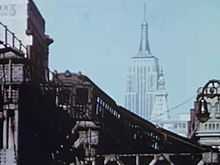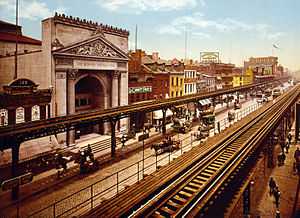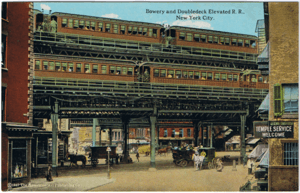IRT Third Avenue Line

_demolished_-_Third_Avenue_Elevated%2C_New_York%2C_New_York_County%2C_NY_HABS_NY-6373-1_(CT).tif.jpg)
The IRT Third Avenue Line, commonly known as the Third Avenue El and the Bronx El, was an elevated railway in Manhattan and the Bronx, New York City. Originally operated by an independent railway company, it was acquired by the Interborough Rapid Transit Company (IRT) and eventually became part of the New York subway system.
The first segments of the line opened in Manhattan in 1878. Service in Manhattan was phased out in the early 1950s and closed completely in 1955, and ended in the Bronx in 1973.
The Third Avenue El was the last elevated line to operate in Manhattan, other than the 1 train on the IRT Broadway–Seventh Avenue Line (which has elevated sections between 122nd and 135th Streets and in Inwood), and was a frequent backdrop for movies filmed in the city. Service on the Second, Sixth and Ninth Avenue El lines was terminated in 1942, 1938, and 1940, respectively.
History



In 1875 the Rapid Transit Commission granted the New York Elevated Railway Company the right to construct the railway from Battery Park to the Harlem River along the Bowery and Third Avenue.[1] At that time the company already operated the Ninth Avenue Elevated, which it acquired in 1871 after the bankruptcy of the West Side and Yonkers Patent Railway.[2] The Manhattan Railway Company took control of the New York Elevated Railroad in 1879. In 1886, the Suburban Rapid Transit Company commenced operations with a railway line over the Harlem River (via a double-decked swing bridge located between the Third Avenue Bridge and Willis Avenue Bridge with the upper deck carrying the express tracks, the lower one the local tracks, and a pedestrian walkway) from the Manhattan Railway's northern terminal at 129th Street to 133rd Street in the southern Bronx—known then as the "Annexed District."[3][4] The Manhattan Railway assumed operations of the Suburban in 1891 as an extension of the Third Avenue Line and through service between the Bronx and Manhattan began in 1896.[5] A 999-year lease of the Manhattan Railway was brokered by the Interborough Rapid Transit Company in 1902, for which rapid transit services in the Bronx, of which the Third Avenue Line was part of, would eventually be coordinated alongside the new subway.[6]
As part of the Dual Contracts, this line was triple-tracked, which allowed for express service. The center track of the Bronx portion opened on January 17, 1916; in Manhattan it was opened on July 9, 1917.[3]
In the 1930s and '40s, as part of the integration of the different subway companies in New York City—the IRT along with Brooklyn–Manhattan Transit (BMT) and Independent Subway System (IND)—the Third Avenue El and its counterparts on Second, Sixth, and Ninth Avenues came under criticism from New York mayor Fiorello La Guardia and his successors. The Els were regarded as blights on their communities and obsolete, since the subways were being built or were planned to replace them.

The IND Sixth Avenue Line and the IND Eighth Avenue Line did indeed render the Sixth and Ninth Avenue Els obsolete, except for a small shuttle that served the Polo Grounds on the Ninth Avenue Line. They were closed by 1940 and demolished by 1941. The Second Avenue El was also gradually demolished from 1940 to 1942, leaving only the Third Avenue El, which was intended to stay in use until the Second Avenue Subway was built to replace it. Pressure against the El from real estate interests soon began, with creation in 1941 of the Third Avenue Elevated Noise Abatement Committee, which consisted of what the New York Times described as "men in the real estate business." The committee initially sought a decrease in train service, saying the noise from the El "constitutes a menace to health, comfort and peaceable home life." [7] At the time the El was closed in Manhattan in 1955, the East Side was left with only the overcrowded IRT Lexington Avenue Line as the only subway east of Fifth Avenue, which is how the system has run to this day.
The system was closed in sections from 1950 to 1973. First, the South Ferry spur was closed in 1950, which connected South Ferry to Chatham Square in Manhattan. This forever closed the South Ferry elevated station, which had served all four IRT El lines that originally ran in Manhattan. Next to close was the City Hall spur in 1953, which started at Park Row in Manhattan and then connected with the South Ferry spur at Chatham Square.

On May 12, 1955 the main portion of the line closed from Chatham Square to East 149th Street in the Bronx, ending the operation of elevated service in Manhattan. The removal was a catalyst in a wave of new construction[8] adding property values on the East Side, and the head of the Real Estate Board of New York suggested that Third Avenue be renamed "The Bouwerie" to symbolize the transformation.[9]
In the 1960s, the remaining service was named the 8. Finally, the remaining portion of the line in the Bronx from East 149th Street to Gun Hill Road closed in April 1973.
In the Bronx, the line was replaced by the Bx55 bus route making only the stops the former line made, and later became the Bx15 Limited. This former bus route was one of the first to have free transfers with the subway with the transfer points at the 3rd Avenue – 149th Street and Gun Hill Road White Plains Road IRT stations, and was one of three [the B35, which got its free transfer two years later after the Culver Shuttle ended] and the B42 [which replaced the Rockaway Parkway Line] were the others). With the introduction of free bus to subway transfers systemwide, the Bx55 (and B35) lost the special status; the B42 only kept its status because it uses a former trolley right-of-way that terminates within subway fare control.
The El in popular culture
The El was featured in a number of films. Among them:

- The Lost Weekend (1945)
- The Dark Corner (1946)
- June Bride (1948)
- The Naked City (1948)
- The Incident (1967)
- The Doctor and the Girl (1949)
- On the Town (1949)
- Port of New York (1949)
- The Window (1949)
- The Killer That Stalked New York (1950)
- Young Man with a Horn (1950)
- Side Street (1950)
- The Glass Wall (1953)
- Living It Up (1954)
- 3rd Ave. El (1955)
- I'll Cry Tomorrow (1955)
- On the Bowery (1956)
- 12 Angry Men (1957)
- The documentary film Daybreak Express (1958) by D. A. Pennebaker
The El was also the backdrop for Jack Finney's novel Time and Again (1970).
Several early silent films were made of New York's elevated trains, including the Third Avenue El. A documentary, "3rd Avenue El," was made in the 1950s and is available for viewing on the Internet.
Station listing
| Station | Tracks | Opened | Closed | Notes |
|---|---|---|---|---|
| merges with IRT White Plains Road Line | ||||
| Gun Hill Road | all | October 4, 1920[3] | April 29, 1973 | IRT White Plains Road Line |
| 210th Street – Williamsbridge | local | October 4, 1920[3] | April 29, 1973 | originally Williams Bridge – 210th Street |
| 204th Street | local | October 4, 1920[3] | April 29, 1973 | |
| 200th Street | local | October 4, 1920[3] | April 29, 1973 | |
| Bronx Park Terminal | Botanical Garden Spur | May 21, 1902[3] | Nov 14, 1951[10] | End of Line until Oct 4, 1920 |
| split for Botanical Garden Spur North | ||||
| Fordham Road – 190th Street | all | July 1, 1901[3] | April 29, 1973 | transfer to the New York Central's Harlem Line, originally Pelham Avenue |
| 183rd Street | local | July 1, 1901[3] | April 29, 1973 | |
| 180th Street | local | July 1, 1901[3] | April 29, 1973 | |
| split for 179th Street Yard | ||||
| Tremont Avenue – 177th Street, (Bronx Borough Hall) | all | July 20, 1891[3] | April 29, 1973 | originally 177th Street |
| 174th Street | local | July 20, 1891[3] | April 29, 1973 | |
| Claremont Parkway | local | September 19, 1888[3] | April 29, 1973 | originally Wendover Avenue |
| 169th Street | local | September 2, 1888[3] | April 29, 1973 | |
| 166th Street | local | December 25, 1887[3] | April 29, 1973 | |
| 161st Street | local | August 7, 1887[3] | April 29, 1973 | |
| 156th Street | local | July 1, 1887[3] | April 29, 1973 | |
| split for IRT White Plains Road Line from local tracks | ||||
| 149th Street | all | June 16, 1887[3] | April 29, 1973 | IRT White Plains Road Line |
| split for IRT White Plains Road Line from express tracks (also called the Bergen Avenue By-pass) | ||||
| 143rd Street | all | May 23, 1886[3] | May 12, 1955 | |
| 138th Street | all | January 1, 1887[3] | May 12, 1955 | |
| 133rd Street | all | May 17, 1886[4] | May 12, 1955 | transfer to the New York, Westchester and Boston Railway (April 15, 1924 to December 31, 1937) and the New York, New Haven and Hartford Railroad's Harlem River Line (April 15, 1924 to 1931) |
| Willis Avenue | Willis Avenue Spur | November 25, 1886[3] | April 14, 1924 | transfer to the New York, Westchester and Boston Railway and the New York, New Haven and Hartford Railroad's Harlem River Branch |
| split for Willis Avenue Spur | ||||
| merge with IRT Second Avenue Line | ||||
| 129th Street | local | December 30, 1878[11] | May 12, 1955 | |
| 125th Street | all | December 30, 1878[11] | May 12, 1955 | |
| 116th Street | local | December 30, 1878[11] | May 12, 1955 | |
| 106th Street | all | December 30, 1878[11] | May 12, 1955 | |
| 99th Street | local | December 30, 1878[11] | May 12, 1955 | |
| split for 98th Street Yard | ||||
| 89th Street | local | December 9, 1878[12] | May 12, 1955 | |
| 84th Street | local | December 9, 1878[12] | May 12, 1955 | |
| 76th Street | local | December 9, 1878[12] | May 12, 1955 | |
| 67th Street | local | September 16, 1878[13] | May 12, 1955 | |
| 59th Street | local | September 16, 1878[13] | May 12, 1955 | |
| 53rd Street | local | September 16, 1878[13] | May 12, 1955 | |
| 47th Street | local | September 16, 1878[13] | May 12, 1955 | |
| Grand Central Station | 42nd Street Spur | August 26, 1878[14] | December 6, 1923 | |
| Third Avenue | 42nd Street Spur | August 26, 1878[14] | December 23, 1923 | |
| 42nd Street | all | September 16, 1878[13] | May 12, 1955 | IRT Flushing Line, IRT Lexington Avenue Line and IRT 42nd Street Shuttle at Grand Central – 42nd Street |
| split for 42nd Street Spur | ||||
| merge from 34th Street Spur | ||||
| Third Avenue | 34th Street Spur | July 14, 1930 | ||
| Second Avenue | 34th Street Spur | July 14, 1930 | IRT Second Avenue Line | |
| 34th Street Ferry | 34th Street Spur | July 1, 1880 | July 14, 1930 | |
| 34th Street | local | August 26, 1878[14] | May 12, 1955 | |
| 28th Street | local | May 12, 1955 | ||
| 23rd Street | all | August 26, 1878[14] | May 12, 1955 | |
| 18th Street | local | May 12, 1955 | ||
| 14th Street | local | August 26, 1878[14] | May 12, 1955 | |
| Ninth Street | all | August 26, 1878[14] | May 12, 1955 | |
| Houston Street | all | September 16, 1878[13] | May 12, 1955 | |
| Grand Street | all | May 12, 1955 | ||
| Canal Street | all | May 12, 1955 | ||
| merge from City Hall Spur | ||||
| Chatham Square | City Hall spur | March 17, 1879[15] | December 31, 1953 | |
| City Hall | City Hall spur | March 17, 1879[15] | December 31, 1953 | |
| Chatham Square | all | September 16, 1878[13] | May 12, 1955 | original station was north of an at-grade merge from the spur |
| split for IRT Second Avenue Line | ||||
| Franklin Square | all | August 26, 1878[14] | December 22, 1950 | |
| Fulton Street | all | August 26, 1878[14] | December 22, 1950 | |
| Hanover Square | all | August 26, 1878[14] | December 22, 1950 | |
| merge from IRT Ninth Avenue Line | ||||
| South Ferry | all | August 26, 1878[14] | December 22, 1950 | |
Notes
- ↑ Rapid Transit in New York City and in Other Great Cities. prepared by the Chamber of Commerce of the State of New York. 1905. p. 51. Retrieved 2009-02-11.
- ↑ Conkling, Alfred R. (1899). City Government of the United States with a Chapter on the Greater New York Charter of 1897 (4th, revised ed.). New York: D. Appleton and Company. p. 113. Retrieved 2009-02-11.
- ↑ 3.0 3.1 3.2 3.3 3.4 3.5 3.6 3.7 3.8 3.9 3.10 3.11 3.12 3.13 3.14 3.15 3.16 3.17 3.18 3.19 3.20 Fischler, Stan (1997). The Subway: A Trip Through Time on New York's Rapid Transit. Flushing, NY: H&M Productions. pp. 245–249. ISBN 1-882608-19-4.
- ↑ 4.0 4.1 "Just across the River, Opening of a Short Length of Sub-Urban Rapid Transit Railroad" (PDF). The New York Times Company. 18 May 1886. p. 2. Retrieved 19 February 2009.
- ↑ Derrick, Peter (2001). Tunneling to the Future: The Story of the Great Subway Expansion that Saved New York. New York: New York University Press. p. 30. ISBN 0-8147-1910-4.
- ↑ Cudahy, Brian J. A Century of Subways: Celebrating 100 Years of New York's Underground Railways. New York: Fordham University Press. pp. 10–11. ISBN 0-8232-2292-6.
- ↑ "Realty Interests Seek Quieter Third Avenue". The New York Times. Dec 7, 1941.
- ↑ Paumgarten, Nick (July 4, 2011), "Looking for Someone", The New Yorker: 27,
The demolition of the Third Avenue Elevated subway line set off a building boom and a white-collar influx.....
- ↑ New York Times, New Name Urged for Third Avenue, February 7, 1956, page 33
- ↑ New York's El Lines 1867-1955 Electric Railroaders Assn Dec 1956, Bulletin #25
- ↑ 11.0 11.1 11.2 11.3 11.4 "Rapid Transit to Harlem" (PDF). The New York Times Company. 31 December 1878. p. 8. Retrieved 21 February 2009.
- ↑ 12.0 12.1 12.2 "More Elevated Trains, but No Notice on the East Side Road of a Reduction in Fares" (PDF). The New York Times Company. 10 December 1878. p. 8. Retrieved 11 February 2009.
- ↑ 13.0 13.1 13.2 13.3 13.4 13.5 13.6 "The New-York Elevated Railway" (PDF). The New York Times Company. 16 September 1878. p. 8. Retrieved 11 February 2009.
- ↑ 14.0 14.1 14.2 14.3 14.4 14.5 14.6 14.7 14.8 14.9 "Rapid Transit on the Bowery" (PDF). The New York Times Company. 26 August 1878. p. 8. Retrieved 10 February 2009.
- ↑ 15.0 15.1 "Rapid Transit from the City Hall" (PDF). The New York Times Company. 18 March 1879. p. 8. Retrieved 19 February 2009.
References
- Rapid Transit on the Bowery, New York Times August 26, 1878 page 8
- Crossings on Elevated Roads, New York Times March 14, 1879 page 8
- 42d St. Elevated Stops, New York Times December 7, 1923 page 19
- City Brevities, New York Times April 15, 1924 page 10
- 34th St. Elevated Ends Long Service, New York Times July 15, 1930 page 15
- Westchester Line Passes with 1937, New York Times January 1, 1938 page 36
- Old 'El' Link Ends Its 72-Year Uproar, New York Times December 23, 1950 page 23
- City Hall 'El' Spur at End of the Line, New York Times January 1, 1954 page 25
- Last Train Rumbles on Third Ave. 'El', New York Times May 13, 1955 page 1
- Cars are Packed for Last 'El' Trip, New York Times May 13, 1955 page 16
- Third Ave. El Reaches the End of Its Long, Noisy, Blighted, Nostalgic Life, New York Times April 29, 1973 page 24
Further reading
- Stelter, Lawrence, and Lother Stelter. (1995). By the El: Third Avenue and Its El at Mid-Century. Flushing, NY: H&M Productions. ISBN 1-882608-12-7.
External links
| Wikimedia Commons has media related to IRT Third Avenue Line. |
- Remembering the Third Avenue El, MTA.info
- nycsubway.org—nycsubway.org The Third Avenue El:
- archive.org - The Third Avenue El (ca.1950s)
- - Bronx 3rd Avenue El (1900-1973)
- Gotham Center - The Rise and Decline of New York City's Third Avenue Elevated Train Line
- Historic American Engineering Record (HAER) No. NY-68, "Interborough Rapid Transit Company, Third Avenue Elevated Line, New York, New York County, NY", 85 photos, 1 color transparency, 3 data pages, 6 photo caption pages
- 1953 Vivian Maier photo by 59th St station, view southwards towards Chrysler Building
| ||||||||||||||||||||||||||||||||||||||||||||||||||||||||||||||||||||||||||||||||||
| ||||||||||||||||||||||||||||||||||||||||||||||||||
| |||||||||
| ||||||||||||||||||||




